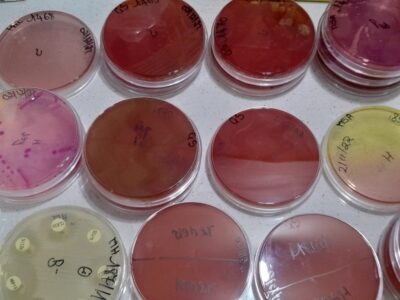Main content
Neglected tropical diseases (NTDs) represent a group of conditions that origi- nally by and large repre- sent the classical tropical diseases other than malaria. They were recognized around 2000, a time when most of the research and funds in tropical medicine went to ‘the big three’: malaria, tuberculosis and HIV/AIDS. The NTDs are characterized by their tendency to affect poor popula- tions who have no access to appropriate health care or safe and effective drugs and are severely neglected in terms of research. For example, sleeping sickness was still being treated by intravenous administration of toxic drugs based on heavy metals (arsenic) that could actually kill the patient. More than a billion people worldwide are infected with one or more NTDs. The World Health Organization (WHO) currently has twenty diseases in its portfolio, and these now also include relative new- comers such as mycetoma and scabies. The full list of NTDs is much longer (see table on page 5). The WHO policy on NTDs can be found in the recently published roadmap for 2021 – 2030. [1]
In this issue of MT bulletin, we address some of the more classical NTDs in which major progress has been made. The Drugs for Neglected Disease initiative (DNDi) Geneva, Switzerland features in three articles illustrating how new and safe treatments can be delivered using a bench to bedside approach. This has been achieved for sleeping sickness and leishmaniasis, while new (badly needed) approaches are planned for onchocerciasis to supplement mass drug administration (MDA). DNDi has received support for many years, among other donors, from the Netherlands Ministry of Foreign Affairs; this is money well spent! More new treatments will be delivered in the years to come (www.dndi.org), and there is no other option than going full speed ahead with this successful model.
Admit it: you have not been paying much attention recently to leprosy and thought it was eliminated. Think again: the disease is still with us and needs continuous monitoring to avoid compla- cency. Luckily, major progress has been made in prevention by post-exposure prophylaxis using a single dose of rifampin. Another relatively new condi- tion on the NTD list is Buruli ulcer, and the first drug studies are underway.
Besides improved drug treatment, mathematical modelling has become essential for control efforts, being of great value in giving insight into disease development and predicting the effects of interventions. This is now available for a wide range of tropical diseases.
In summary, major progress has been made in the field of NTDs. The challenge lies in ensuring ongoing support for the various efforts and providing for the sustainability of all programs and achievements.
Overview of neglected tropical diseases
| MAIN RESERVOIR | MODE OF TRANSMISSION | GLOBAL BURDEN | |
|---|---|---|---|
| VIRAL DISEASES | |||
| Dengue and Chikungunya fevers* | Human | Vector-borne | 2920 |
| Japanese encephalitis | Zoonotic | Vector-borne | |
| Jungle yellow fever | Zoonotic | Vector-borne | 314 |
| Other arboviral infections | Zoonotic | Vector-borne | |
| Rabies* | Zoonotic | Direct contact | 634 |
| Rift Valley fever | Zoonotic | Vector-borne | |
| Viral haemorrhagic fevers | Zoonotic | Oral/food-borne, vector-borne, direct contact | |
| BACTERIAL DISEASES | |||
| Bartonellosis | Human, zoonotic | Vector-borne, direct contact | |
| Bovine tuberculosis in humans | Zoonotic | Oral/food-borne | |
| Buruli ulcer* | Zoonotic and/or environmental | Unknown | |
| Cholera | Environment | Oral/food-borne | |
| Diarrhoeal diseases (Shigella, Salmonella, E. coli) | Human | Oral/food-borne | 39600 |
| Leprosy* | Human, (zoonotic) | Direct contact | 31.5 |
| Leptospirosis | Zoonotic | Oral/food-borne | |
| Trachoma* | Human | Direct contact | 303 |
| Treponematoses (Yaws, Endemic syphilis, Pinta)* | Human | Direct contact | |
| HELMINTHIC DISEASES | |||
| Dracunculiasis* | Human | Oral/food-borne | |
| Echinococcosis* | Zoonotic | Oral/food-borne | 100 |
| Food-borne trematodiases (Chlonorchiasis, Fascioliasis, Opisthorchiasis, Paragonimiasis)* | Zoonotic | Oral/food-borne | 1870 |
| Loiasis | Human | Vector-borne | |
| Lymphatic filariasis (LF)* | Human | Vector-borne | 1360 |
| Onchocerciasis* | Human | Vector-borne | 1340 |
| Schistosomiasis* | Human, zoonotic | Direct contact | 1430 |
| Soil-transmitted helminthiases (Ascariasis, Hookworm disease, Trichuriasis, Strongyloidiasis)* | Human | Oral/food-borne, direct contact | 1920 |
| Taenia solium (Neuro)Cysticercosis/Taeniosis* | Zoonotic (only taeniosis) | Oral/food-borne | 1610 |
| Toxocariasis and other larva migrans diseases | Zoonotic | Oral/food-borne, direct contact | |
| PROTOZOAN DISEASES | |||
| Amoebiasis | Human | Oral/food-borne | |
| Balantidiasis | Zoonotic | Vector-borne | |
| Chagas disease* | Zoonotic | Vector-borne, fetal-maternal, blood | 232 |
| Giardiasis | Human | Oral/food-borne | |
| Human African trypanosomiasis (HAT)* | Human, zoonotic | Vector-borne | 79.0 |
| Leishmaniasis* | Human, zoonotic | Vector-borne, fetal-maternal, blood | 774 |
| ECTOPARASITIC DISEASES* | |||
| Myiasis | Vector-borne | ||
| Scabies | Human | Direct contact | |
| Snake bite envenoming* | Environment | Direct contact | |
| Mycetoma, chromoblastomycosis and other deep mycoses* | Environment | Direct contact |
b) the average in all-age DALYs (thousands) in 2017 (source: GBD 2017 DALYS and HALE Collaborators. Global, regional, and national disability-adjusted life-years (DALYs) for 359 diseases and injuries and healthy life expectancy (HALE) for 195 countries and territories, 1990-2017: a systematic analysis for the Global Burden of Disease Study 2017. Lancet. 2018 Nov 10;392(10159):1859-1922.
* indicates the 20 diseases categorized by WHO as belonging to the neglected tropical diseases.
Major progress has been made in the field of ntds. The challenge lies in ensuring ongoing support for the various efforts and providing for the sustainability of all programs and achievements
References
- World Health Organization. Ending the neglect to attain the sustainable development goals: a road map for neglected tropical diseases, 2021-2030. Geneva: World Health Organization; 2020. 55 p.



















































